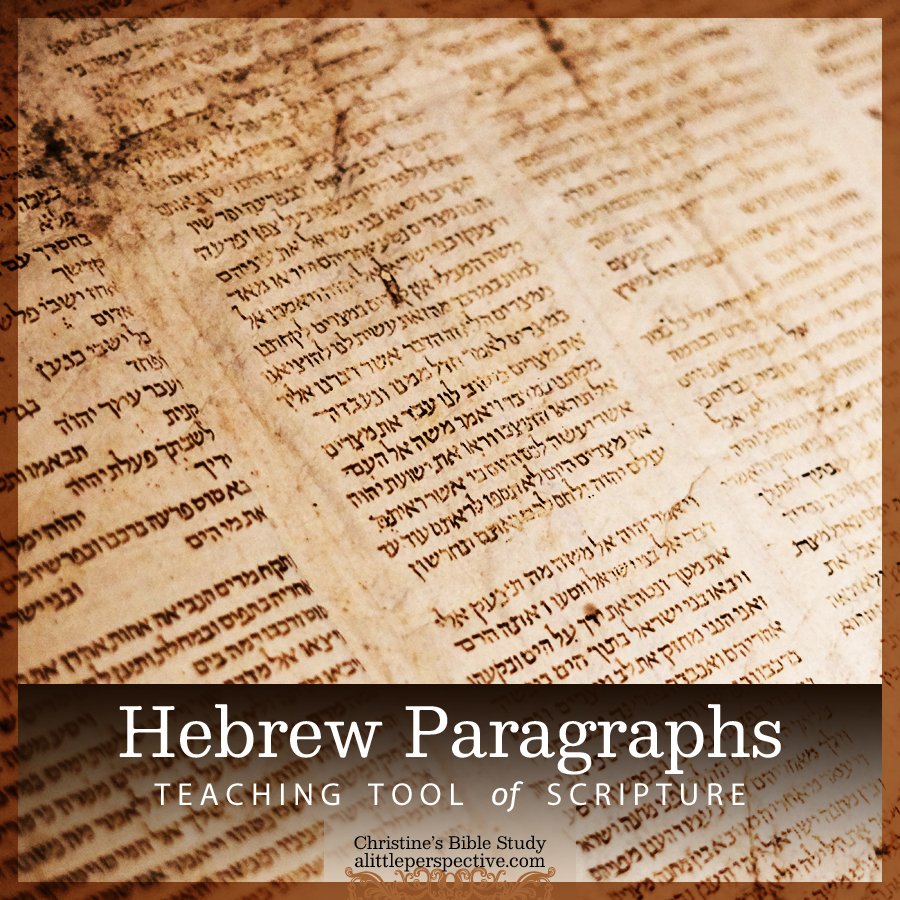The Teaching Tools of Scripture
God’s paragraph divisions, when He has concluded one topic and is ready to go on to the next, are present in the original Hebrew text of the Scripture. These paragraph divisions have been preserved by the Hebrew scribes who faithfully copied every letter of Scripture without variation. They were discarded by the English translators, because admittedly, they sometimes do not make sense to human logic. But that is the point! God has divided His paragraphs the way He has for a reason: He is trying to teach us something. Where the paragraph divsions aren’t are often just as instructive as where they are.
There are two kinds of divisions, a weak division and a strong division.
A weak division is called a parsha stumah, meaning, a paragraph followed by a stumah break. I mark the end of stumah or weak paragraphs with {s} since the Hebrew word for it begins with the ‘s’ sound. The stumah indicates the conclusion of one facet of a continuing theme.
A strong division is called a parsha p’tuchah, meaning, a paragraph followed by a p’tuchah break. I mark the end of p’tuchah or strong paragraphs with {p} since the Hebrew word for it begins with the ‘p’ sound. The p’tuchah indicates a single, strong paragraph, not part of a series; or the conclusion of a continuing or overarching theme.
Many years ago when I first began studying Scripture with the teaching tool of Hebrew paragraph divisions, I made outlines of each book with its divisions marked, and wrote out the single topic for each paragraph. I would encourage everyone to do this for themselves, because the process of discovering each paragraph’s topic taught me a great deal about Scripture and God’s way of thinking. The Hebrew Bible in English includes all the paragraph divisions for each chapter of the Hebrew Testament.
Gen 1:1-2:3 Hebrew paragraph divisions
Gen 1:1-5 {p} First day of Creation: space, time, matter, energy (light).
Gen 1:6-8 {p} Second day of Creation: firmament of the heavens.
Gen 1:9-13 {p} Third day of Creation: dry land, plant life.
Gen 1:14-19 {p} Fourth day of Creation: lights in the firmament of the heavens.
Gen 1:20-23 {p} Fifth day of Creation: birds, sea life.
Gen 1:24-31 {p} Sixth day of Creation: animal life on land, man.
Gen 2:1-3 {p} Seventh day of Creation: rest.
The divisions make it apparent that the days of creation are significant. There are Hebrew words for other lengths of time, such as years or eons, if those units of time were meant. But God chose the Hebrew yom – “day” – the regular 24-hour day. It sometimes comes as a shock to realize that a day as a unit of time, is one of the few that do not depend on the sun, moon, or stars for marking it. The 24-hour day is the time it takes for the earth to revolve on its axis one revolution; no sun or moon is needed.
The teaching tool of paragraph divisions, then, teaches us the origin of the seven-day week, serving as a reminder every week that God is our Creator.
The very next paragraphs of Scripture, following the Creation account, are:
Gen 2:4-3:15 {s} Disobedience to YHVH’s command is sin.
Gen 3:16 {s} Consequences for the woman.
Gen 3:17-21 {p} Consequences for the man.
Two weak paragraphs are followed by a strong paragraph. I grouped these three paragraphs together in my notes, since the strong marker at the end of Genesis 3:21 indicates the conclusion of an overarching theme, begun in Genesis 2:4. The nature of weak and strong paragraphs in Scripture, then, introduces another teaching tool – that of Strong Themes.
Hebrew paragraph divisions are only present in the Hebrew Testament.
Examples:
Genesis 1:1-2:3, The strong Hebrew paragraph divisions
Genesis 2:4-3:21, The weak Hebrew paragraph divisions
Genesis 1:1-6:8, Summary and examples
Genesis 24, Introduction and example
Genesis 33 and 34, Finding the paragraph topics and common themes
Exodus 6 and 7, The teaching tools of Scripture in the first plague
Exodus 8 and 9, God multiplies His wonders
Deuteronomy 6:4-7:11, Strong paragraph division reveals previously unseen truth
1 Samuel 9 and 10, How the Hebrew paragraphs teach God’s main points

















Leave a Reply